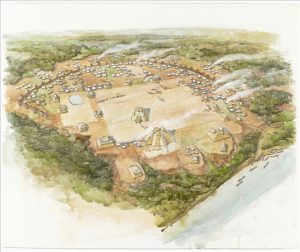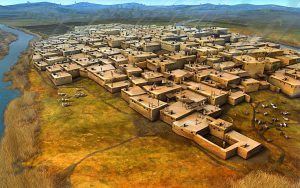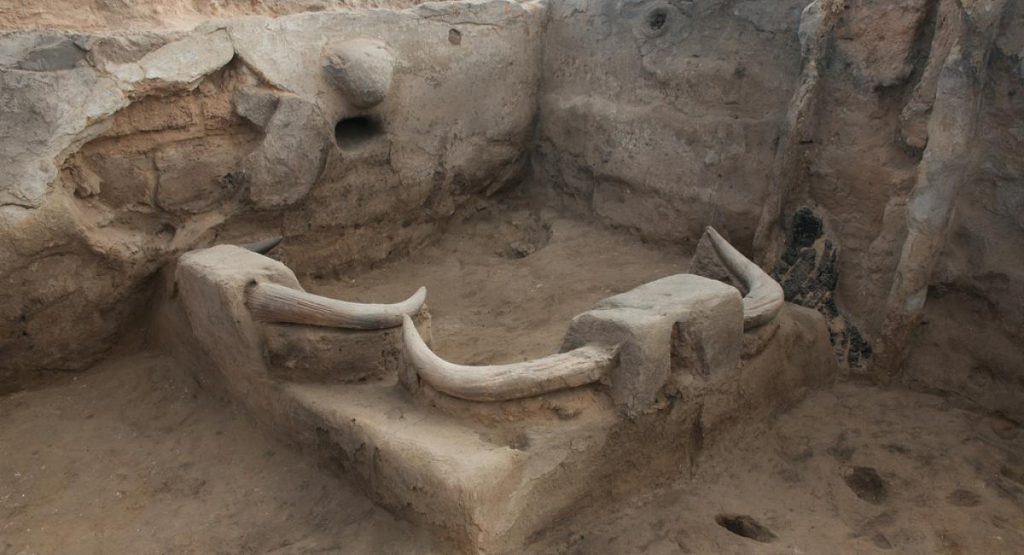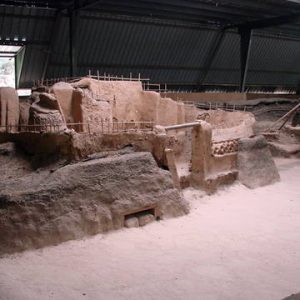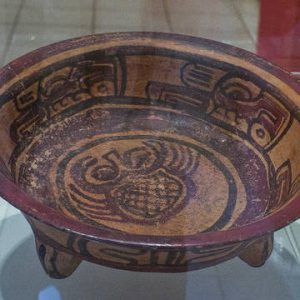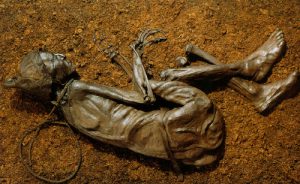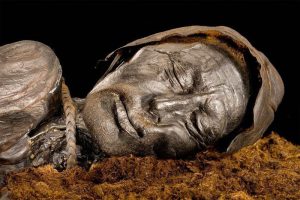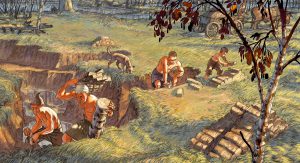Today’s post comes from Curtis Eckley, class of 2019 and Art Center Student Docent.
This past month, the Dia Art Foundation announced its recent acquisition of six Anne Truitt sculptures that will go on long-term view at their Dia:Beacon gallery space, starting on May 5, 2017
Ancient Mississippi: Moundville
When one looks at an archaeological site one of the questions they are trying to answer is what type of society produced this site. There are a lot of different clues within the archaeological site that can tell help answer that question. One good example of how social archaeology works is Moundville.
Moundville was an Ancient Native American site located in Mississippi. It was occupied from AD 1000-AD 1450. It was a village built using Wall-Trench architecture. It was well planned, in a roughly square formation using a mound-plaza layout. It was also a cultural center. We know this because there were remnants of pottery found at the site.
With just the information above we can tell that Moundville was created by a society that was at least a Segmentary Society. In other words, we can tell that the people who built Moundville were not nomadic people. They lived permanently at Moundville. We can tell this because the settlement was protected forests on three sides. The fact that Moundville was built it in a protected area suggests that there was warfare and warfare only occurs once a settlement becomes permanent. This leads us to deduce that they were a Segmentary Society because there was evidence of agricultural as well as hunting found at the sites surrounding Moundville.
We can also infer that Moundville was the social center because there were many smaller sites surrounding Moundville, suggesting that the most people lived in Moundville. The people at Moundville were producing highly sophisticated pottery, which also leads us to believe that it was the center of this society. This also suggests that there a hierarchy.
If a society has enough people where not everybody has to produce food, then there are people who can devote their time to other jobs. Once that occurs, the society also needs a ruler, which creates a hierarchy. We also know that there was some sort of hierarchy because the mounds were different in size. One can infer that the bigger mounds were made for the elite and the smaller mounds for the peasants. This becomes especially apparent when one takes the artifacts that were buried in the mound into account.
In conclusion, with the information given by the archaeology, we have managed to reconstruct the story of the society that lived at Moundville.
Sources:
N/a. “Ancient Site.” Ancient Site. Moundville Archaeological Park, n.d. Web. 13 Feb. 2017.
http://moundville.ua.edu/ancient-site/
Images:
https://www.ua.edu/news/wpcontent/uploads/2005/12/rattlesnake_disk.jpg
http://s821.photobucket.com/user/Ojibwa/media/Moundville.jpg.html
Further Readings:
http://www.encyclopediaofalabama.org/article/h-1045
http://www.ancient.eu/moundville/
Understanding Neolithic Life: Çatalhöyük
Around 7,400 BCE, people first settled in Central Turkey at the site of Çatalhöyük. By 6,500 BCE, the site was a Neolithic urban center. Several construction phases of tightly packed mud brick houses led to the formation of a tall mound at the site. The excavation of the mound and the examination of discovered features and artifacts led to the understanding of what life was like in the Neolithic community and how it developed over time. The site provides great insight into how early farming communities functioned and what activities and items they valued.
The dense settlement was made up of mud brick houses, each with an entrance on the roof. All of the houses were closely packed together, with zero space dedicated to streets or major pathways. Evidence of crop cultivation and domesticated animals proves that the last group to occupy Çatalhöyük was a segmentary society of farmers and herders, not a mobile group of hunter-gatherers. It was not a large enough settlement to be considered a chiefdom or state, but still had up to 9,000 residents. Inside the mud brick houses, there were cooking spaces with ovens and hearths. As agriculture was beginning to become the dominant way of life, food preparation was developing. More serious cooking tools could be built because people had the ability to settle down and build houses, instead of temporary camps.
The presence of wall paintings and relief sculpture contributes to the understanding of the culture and beliefs of the people at Çatalhöyük. The plastered walls of the houses were used to display painted geometric designs or reliefs of wild animals. One of the most abundant forms of art found at the site was clay figurines. They were found throughout various areas of the houses, but usually in garbage pits. The Çatalhöyük people may have used the sculptures to protect against evil spirits or as wish tokens. Another important art form was the installation of animal remains into the main rooms of the houses. Many bull skulls can be found lining the walls of the rooms, with huge horns sticking out into the living space. The presence of undomesticated animals in the art of the Çatalhöyük people may show a desire to remember the recent past, when hunting was still the main source of food.
The art, organization of houses, and presence of agriculture suggests that the residents of the Çatalhöyük site were in a position in which they could stay in one spot and hold territory. They had stable enough resources to devote time to the arts, but used paintings and installations to connect them to the memories of the past way of life. Çatalhöyük was one of the largest settlements of its time, and by examining the ancient structures and artifacts we can gain insight into how humans lived during the beginning stages of farming and crop cultivation.
References:
https://www.khanacademy.org/humanities/prehistoric-art/neolithic-art/a/atalhyk
http://whc.unesco.org/en/list/1405
Images:
http://www.sci-news.com/archaeology/science-catalhoyuk-map-mural-volcanic-eruption-01681.html
Further Reading:
http://www.ancient-origins.net/ancient-places-asia/9500-year-old-honeycomb-city-atalh-y-k-00840
http://www.hurriyetdailynews.com/new-findings-at-catalhoyuk-.aspx?pageID=238&nid=94106
Disaster Archaeology: Joya de Cerén
Natural disasters are categorized as devastating events in nature that occur abruptly and often with terrible ramifications. Violent storms, mudslides and volcanic eruptions have been the cause of destruction in many an ancient civilization, often leaving behind no trace of the people who inhabited them. However, in a bit of an ironic twist, these same circumstances are what have preserved many ancient cultures for hundreds and, in some cases, thousands of years. One such example of this is Joya de Cerén, the literal translation of which is ‘The Jewel of Cerén’.
Located in present day El Salvador, Joya de Cerén was a pre-Hispanic farming community that was active during the Mayan Classic period (A.D. 300-900). This archaeological site was preserved in the same way as the famous Italian city of Pompeii. Around 600 A.D. a nearby volcano, Loma Caldera, erupted and covered the surrounding area in thick layers of ash and other volcanic debris. This natural disaster acted as a natural preserving agent that protected the architecture, artifacts, ecofacts and even the fields used by the ancient farmers. All of which was still as the inhabitants had left them while fleeing. As much as this site was a miraculous find for archaeologists with its remarkable level of preservation, it was made even more unique due to the fact that the area was largely non-elite. For the most part research into Mayan culture has focused on the rich and elite of society as their marks have stood the test of time more easily than that of the general populace.
However, Joya de Cerén gives the world a rare view into the lives of common ancient Mesoamerican farmers. The layers of volcanic ash allowed for the preservation of the architecture and artefacts of the ancient site that were left ‘in-situ’ or in their original positions of storage and use. The personal dwellings give us a clear picture of the day-to-day lives of an ancient Mesoamerican farmer. Religious items, animal remains and even the sleeping mats have been preserved, all ordinary items at the time that would seem to have no large importance on their own but provide much valuable information together (Joya de Cerén Archaeolofical Site). Several other types of structures have been preserved as well, such as religious and community buildings, storehouses and even a sweat bath. The fields were also well preserved and show what kinds of foods were the staple of these ancient people’s diets. These structures and their intact contents give detailed information about how the village functioned as a community, their beliefs and traditions and even their dietary practices. Again all features that might seem meaningless to the average person, but allow researchers to gain a clearer understanding of the life these ancient people lived and how that relates to the people in the present.
Sources:
Banyasz, Malin G. “From the Trenches – Off The Grid – Archaeology Magazine Archive.” From the Trenches – Off The Grid – Archaeology Magazine Archive. Archaeological Institute of America, Mar. 2012. Web. 05 Feb. 2017.
http://archive.archaeology.org/1203/trenches/joya_de_ceren_maya_el_salvador.html
Centre, UNESCO World Heritage. “Joya de Cerén Archaeological Site.” UNESCO World Heritage Centre. UNESCO, n.d. Web. 05 Feb. 2017.
http://whc.unesco.org/en/list/675/
Images:
http://whc.unesco.org/en/list/675/gallery/
http://whc.unesco.org/en/list/675/gallery/
Further Reading:
http://www.elsalvadortravelnetwork.com/joya-de-ceren.html
http://www.colorado.edu/anthropology/gradstudy/joya-de-ceren-el-salvador
Tollund Man: Peat Bogs Today and in the Iron Age
Tollund man, discovered in a bog in Denmark in 1950, is so well preserved that the two brothers who found him thought he was a recent murder victim. Based on carbon testing, he lived during the Iron age and died around 3-400 BC aged 30-40 years. After being hanged he was laid in the peat bog in a sheepskin cap, a belt, and a noose tied around his neck. Instead of decomposing, the peat moss killed bacteria and prevented the decomposition of the body.
Ever since Tollund man was found, both archeologists and the media have debated and posed questions about the manner of his death. Superficially, the circumstances of Tollund man’s death seems to correspond with a section of Tacitus’ later description of the Semnones, a germanic tribe. He wrote in the second century, that, “They hang traitors and renegades in trees, cowards, combat evaders (afraid to go to war) and unnaturally immoral people they lower into filthy swamps and cover them with branches”(“Why Did He Have to Die?”). However, Tacitus was writing about 400 years after Tollund man was left in the bog and Tollund man’s burial does not seem to line up with the burial of a criminal. Archeologists have pointed out that he was placed in the bog in a sleeping position. It is also likely that those who buried him closed his eyes and mouth after death. Because of this his death is often seen as a sacrifice to a god. Other bog bodies do not show the same special treatment that Tollund man’s does. The bodies of Kayhausen boy (500-100 B.C.) and Yde girl (54 B.C.-128 A.D.) may have had physical deformities that ultimately led to violent deaths. Yde girl’s hair was also shaved on one side a sign that she might have been an adulteress (French).
Though Tollund man was likely put in the peat bog to be forgotten, either as a criminal or more likely as a sacrifice to the gods, it was this location that insured his preservation. Bogs are treasure troves for modern archeologist, and the artifacts recovered from them can often reveal information about people’s lives that would not otherwise survive. Bodies are not the only things found in peat bogs, archeologist and locals have also found jewelry, weaponry, battle armor, farming equipment, and even butter (French). In the peat surround the Tollund man two peat spades and a wooden walkway were also found (“The Bog Where the Tollund Man Was Discovered”). Reconstructed image of peat cutting during the Iron age, when Tollund Man would have lived. The existence of these artifacts also point to the important role that peat bogs also played for ancient cultures. It has been argued peat bogs, were seen as ‘gateways to the spiritual world’ as well as a source of fuels, as it is still seen today (French). All together the bog artifacts can indicate what peat bogs meant to Iron age cultures and can help unravel the continued questions that the Tollund man and other bog bodies pose.
Sources:
French, Kristen C. “The Curious Case of the Bog Bodies – Issue 27: Dark Matter.” Nautilus. N.p., 06 Aug. 2015. Web. 02 Feb. 2017. http://nautil.us/issue/27/dark-matter/the-curious-case-of-the-bog-bodies
“Why Did He Have to Die?” The Tollund Man – Death. Silkeborg Museum and Amtscentret for Undervisning, 2004. Web. 02 Feb. 2017. http://www.tollundman.dk/doeden.asp
“The Bog Where the Tollund Man Was Discovered.” The Tollund Man – The Bog. Silkeborg Museum and Amtscentret for Undervisning, 2004. Web. 02 Feb. 2017. http://www.tollundman.dk/mosen.asp
Read More:
More on the Tollund Man: http://www.atlasobscura.com/places/tollund-man
Bog bodies and violence: http://archive.archaeology.org/online/features/bog/violence1.html
Bog bodies poetry and science: https://www.elsevier.com/connect/the-bone-vault-poetry-and-palaeontology-of-the-bogs

